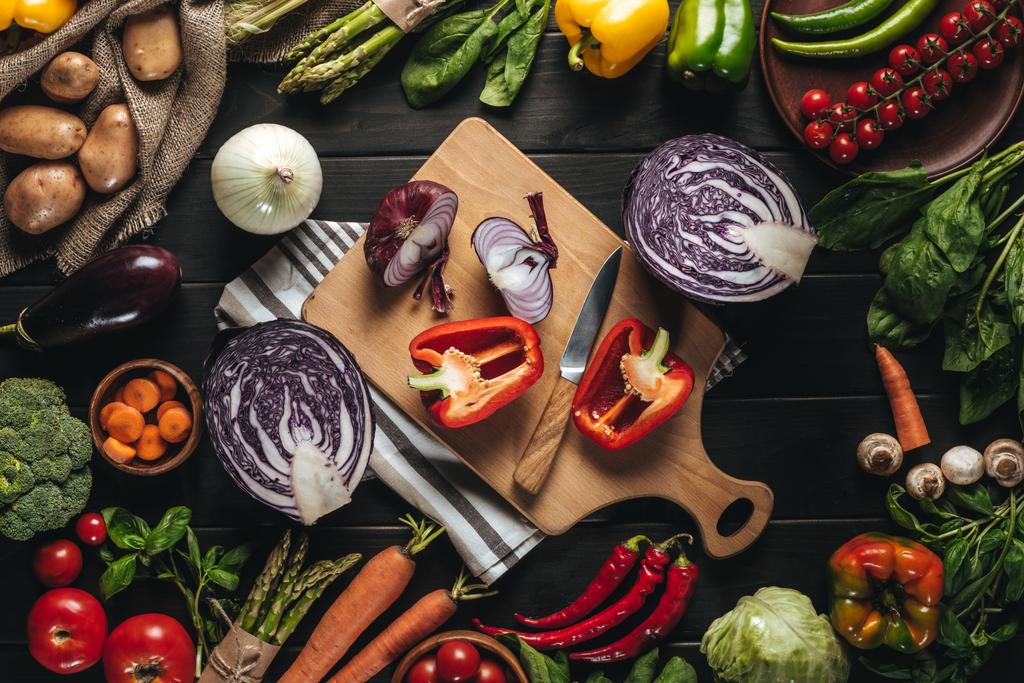Can I eat vegetables on keto? The principle on which the keto diet is based is also very simple: consume few carbohydrates. So not that much should go wrong. But wait a minute: If I’m trying to eat healthily and want to eat a lot of vegetables, which vegetables are low in carbohydrates and even allowed on the ketogenic diet? Good question! You can find out more about this here.
Which vegetables on keto are allowed?
There is a very simple rule of thumb regarding the types of vegetables allowed on the keto diet:
- Vegetables that grow above ground are usually low-carb and should therefore be consumed in large quantities (we’ll see how “low” in a moment).
- Vegetables that grow underground contain more carbohydrates, so you should be more careful here (especially with potatoes).
There are of course exceptions to every rule. It is therefore better to inform yourself in advance about the nutritional values of each type of vegetable.
RELATED: Keto Diet and Gastritis – Everything You Need to Know
10 Keto-Friendly Vegetables
We’ve rounded up ten “keto-ready” veggies for you — tasty and nutrient dense, but low in carbs. Below is a list of carbohydrates per 100 grams.
Spinach – 1g
Spinach is an extremely low-carb vegetable, high in vitamins and minerals, and can be used in a variety of ways. It goes wonderfully with eggs, cheese or salmon.
Bamboo shoots – 1g
This low-carb vegetable is best known from Chinese and Thai cuisine. Bamboo shoots not only have few carbohydrates, but also score points with only 14 kcal per 100 grams.
Asparagus – 2 g
Worshiped by the ancient Egyptians as the “food of the gods” and an aphrodisiac, asparagus is one of the oldest cultivated vegetables in the world. Whether steaming, boiling, baking or grilling, there are no limits to your imagination when preparing asparagus. We especially recommend the asparagus wrapped in crispy ham – nutritious and delicious!
Avocado – 2g
Not only low in carbohydrates, but also rich in nutritious fatty acids. . Okay, the avocado is not a vegetable from a botanical point of view, but a fruit, but in Europe it is mainly used for savory dishes. Avocado tastes particularly good in salads or in the classic guacamole version, but you can also simply enjoy it on its own with a little salt and lemon juice.
Cauliflower – 3 g
Perhaps the classic among low-carb vegetables. Roasted cauliflower from the oven is particularly recommended – wonderfully crispy on the outside and tender as butter on the inside. Cauliflower can also be used super well as a low-carb pizza crust, so-called “cauliflower crust”.
RELATED: Keto Valentine’s Day Gifts: Best Ideas for 2024
Cabbage – 3 g
Another low-carb vegetable is cabbage. Who doesn’t love buttered kale with bacon and onions or stir-fried Asian cabbage?
Zucchini – 3 g
As with cauliflower, zucchini can also be used to make low-carb alternatives to pasta, such as zucchini pasta!
Green beans – 4 g
Green beans convince us with their great variety – from salads to stews to side dishes, everything is possible with the healthy vegetables. They taste especially good with added fats like butter, an olive oil vinaigrette or bacon.
Broccoli – 4 g
Another healthy vegetable that can replace pasta, rice or potatoes. Fry some broccoli in butter or add some cheese, e.g. in the form of a delicious broccoli cheese soup – a healthy and varied side dish for all kinds of dishes.
Brussels sprouts – 5 g
Nutty, filling and nutritious, it tastes particularly good with olive oil and garlic or with crispy fried bacon. You can also simply steam it and serve it with a cheese and cream sauce.
How Much Vegetables Can I Eat on Keto?
If you are now wondering how many green vegetables you can really eat on a keto diet, you should first define your daily carbohydrate requirements. A rough rule of thumb for the keto diet is 20-50 grams of carbs per day. But that is a completely separate topic, and this is where opinions often differ.
It is often said that a ketogenic diet requires a complete avoidance of fruit and vegetables. Here is the proof to the contrary.
Why Vegetables on Keto Are So Good
As we know, in a ketogenic diet, you lower the amount of carbohydrates to under 30 g (or under 15-20 g for more severe forms). With 3 meals a day, however, one meal can contain at least 5 g of carbohydrates.
If you only eat a fried egg or a “bulletproof coffee” in the morning, you can also consume 10 g of carbohydrates from vegetables in the two remaining meals.
Other foods also contain small amounts of carbohydrates, e.g. eggs and nuts as well as dairy products.
RELATED: Red Raspberry Ketones: Exogenous Ketones for Ketosis 90 Capsules
When You Should Eat Vegetables on Keto
At the beginning of a ketogenic diet, we recommend consuming less dairy products and getting the carbohydrates primarily from nutrient-rich vegetables. So you can easily consume 600-900 g of vegetables per day.
You can do without dairy products without hesitation if you cover your calcium requirements with calcium-rich vegetables such as kale, rocket or spinach. 100 g of kale contains almost twice as much calcium as 100 ml of milk.
A ketogenic diet done right (not the dreaded “dirty keto”) actually provides MORE vegetables than the average diet.
Vegetables form the basis of every meal on the ketogenic diet and replace potatoes, rice and pasta as a “filling side dish”. The result is a much greater variety of nutrients on the plate.
Finally, the table: So many vegetables you can eat on keto
In the left column you can see different types of vegetables in rather random order. On the right you can see how much (in grams) you can eat this type of vegetable to achieve 5 g or 10 g of carbohydrates.
For example, 833 g of mushrooms, 403 g of pak choi (bok choi) or 664 g of sauerkraut contain only 5 g of carbohydrates. Who would have thought so?
Keto Vegetables: Your List
| 5 g carbs | 10 g carbs | |
| Artichoke hearts | 313 | 625 |
| Eggplant | 201 | 402 |
| Oyster mushrooms | 192 | 385 |
| Bamboo shoots (fresh) | 521 | 1042 |
| Cauliflower | 217 | 435 |
| Green beans | 98 | 196 |
| Broccoli | 185 | 370 |
| Broccoli (young stems) | 167 | 333 |
| Champignons | 833 | 1667 |
| Chicory | 208 | 417 |
| Chinese cabbage | 403 | 805 |
| Cocktail tomatoes | 167 | 333 |
| Salad | 500 | 1000 |
| Iceberg salad | 333 | 667 |
| Endives | 403 | 806 |
| Salad greens | 625 | 1250 |
| Fennel | 167 | 333 |
| Green onions | 102 | 204 |
| Green cabbage | 200 | 400 |
| Snow peas | 50 | 100 |
| Carrots | 74 | 147 |
| Kohlrabi | 135 | 270 |
| Lettuce | 472 | 943 |
| Oyster mushrooms | 152 | 303 |
| Onions | 153 | 307 |
| Turnip | 106 | 213 |
| Mangold | 833 | 1667 |
| Morels | 1000 | 2000 |
| Okra | 100 | 200 |
| Pak Choi | 403 | 805 |
| Peppers, yellow | 94 | 189 |
| Peppers, green | 172 | 345 |
| Peppers, red | 78 | 156 |
| Parsnips | 41 | 83 |
| Chanterelles | 2941 | 5882 |
| Pick lettuce | 179 | 357 |
| Portobello | 1000 | 2000 |
| Green beans | 100 | 200 |
| samphire | 114 | 227 |
| Radicchio | 333 | 667 |
| Radishes | 235 | 469 |
| Radish | 209 | 418 |
| Rhubarb | 368 | 735 |
| Romaine salad | 294 | 588 |
| Romanesco | 214 | 427 |
| Rose cabbage | 152 | 304 |
| Beetroot | 60 | 119 |
| Red cabbage | 141 | 282 |
| Ruccola | 238 | 476 |
| Cucumber | 278 | 556 |
| Sauerkraut | 664 | 1328 |
| Shallots | 152 | 303 |
| Salsify | 236 | 472 |
| Celery root | 222 | 444 |
| Shiitake | 111 | 222 |
| Asparagus, green | 250 | 500 |
| Asparagus, white | 250 | 500 |
| Spinach | 820 | 1639 |
| Cabbage | 185 | 370 |
| Celery | 229 | 459 |
| Turnip | 100 | 200 |
| Porcini mushrooms | 943 | 1887 |
| Thai asparagus | 250 | 500 |
| Tomatoes | 192 | 385 |
| Topinambur | 125 | 250 |
| White cabbage | 120 | 239 |
| Savoy cabbage | 171 | 342 |
| Zucchini | 222 | 444 |
| Sugarloaf | 333 | 667 |
| Sugar snap | 50 | 100 |
| Onion, red | 102 | 204 |
| Onion, white | 102 | 204 |
RELATED: Vibrant Greens: Organic Green Superfood Powder 300g
FAQ
What vegetables are best for a keto diet?
Low-carb, non-starchy vegetables are ideal for a keto diet. These include leafy greens (like spinach, kale, and lettuce), cruciferous vegetables (like broccoli, cauliflower, and cabbage), and other options like zucchini, bell peppers, asparagus, and cucumbers.
Can I eat root vegetables on keto?
Root vegetables such as potatoes, carrots, and beets are higher in carbs and should be consumed in moderation or avoided on a strict keto diet. However, some root vegetables like radishes and turnips can be included in smaller amounts.
Are tomatoes and onions keto-friendly?
Tomatoes and onions can be included in a keto diet, but in moderation due to their higher carb content compared to other vegetables. It’s important to keep track of the portion sizes when consuming these.
How many vegetables should I eat on keto?
While there’s no one-size-fits-all answer, it’s generally recommended to have at least 2-3 servings of non-starchy vegetables per day on a keto diet. This ensures you get enough fiber, vitamins, and minerals.
Can I have salads on a keto diet?
Yes, salads are great for a keto diet, especially when made with low-carb vegetables and high-fat dressings. Adding protein sources like chicken, fish, or cheese can make them more satisfying.
What about vegetable oils on keto?
While vegetable oils are high in fat, not all are recommended for keto. Oils like olive, coconut, and avocado are preferred. Highly processed oils, such as soybean or canola oil, are generally avoided on a keto diet due to their inflammatory properties.
Do I need to worry about carbs in vegetables?
Yes, while vegetables are healthy, their carb content can add up, especially if you eat a lot of them. It’s important to track the carbs in vegetables to stay within your daily carb limit on a keto diet.
Can I drink vegetable juice on keto?
Vegetable juices can be included in a keto diet, but it’s important to make sure they are low in carbs and don’t contain added sugars. Juicing also removes fiber, so eating whole vegetables is generally more beneficial.
What about legumes and beans?
Most legumes and beans are high in carbs and not typically included in a strict keto diet. However, some beans like black soybeans and green beans can be consumed in moderation.
How can I make sure I’m getting enough nutrients from vegetables on keto?
Diversify your vegetable intake to include a variety of colors and types. This ensures a wide range of nutrients. If you’re concerned about nutrient deficiencies, consider consulting with a dietitian or a healthcare provider.
Remember, individual responses to a ketogenic diet can vary, so it’s important to listen to your body and adjust your diet as needed. It’s also beneficial to consult with a healthcare professional or a dietitian when making significant changes to your diet.






[…] RELATED: Vegetables on Keto: What’s Allowed? […]
[…] RELATED: Vegetables on Keto: What’s Allowed? […]